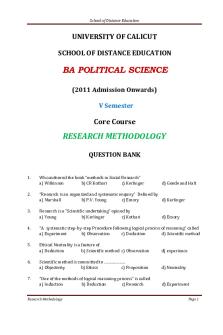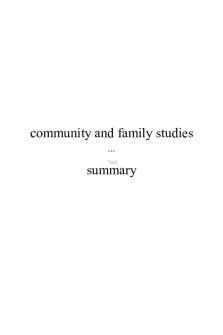RESEARCH METHODOLOGY SAMPLE FOR SOCIAL RESEARCHES.pdf PDF

| Title | RESEARCH METHODOLOGY SAMPLE FOR SOCIAL RESEARCHES.pdf |
|---|---|
| Author | M. Otundo Richard |
| Pages | 6 |
| File Size | 225.5 KB |
| File Type | |
| Total Downloads | 432 |
| Total Views | 865 |
Summary
CHAPTER THREE RESEARCH METHODOLOGY 3.1 Introduction This chapter discussed the following: research design, target population, sample size and sampling procedure, data collection method / procedure, research instruments and data analysis methods. 3.2 Research Design According to Kombo and Tromp (2006...
Description
Accelerat ing t he world's research.
RESEARCH METHODOLOGY SAMPLE FOR SOCIAL RESEARCHES.pdf Martin Otundo Richard
Related papers
Download a PDF Pack of t he best relat ed papers
IMPACT OF MULT INAT IONAL PROJECT S ON T HE WELFARE OF T HE COMMUNIT Y; A CASE ST U… Mart in Ot undo Richard INVEST IGAT ION ON T HE EFFECT S OF OIL EXPLORAT ION ON T HE ECONOMY, ENVIRONMENT & SOCIET … Elim Pet er PRODUCT DEVELOPMENT ST RAT EGIES AND PERFORMANCE OF T OURISM SECT ORS, KENYA marvin ochieng
CHAPTER THREE RESEARCH METHODOLOGY 3.1 Introduction This chapter discussed the following: research design, target population, sample size and sampling procedure, data collection method / procedure, research instruments and data analysis methods. 3.2 Research Design According to Kombo and Tromp (2006), a research design can be regarded as an arrangement of conditions for collection in a manner that aims at combining relevance with the research purpose. The study will employ a descriptive research design. This approach will aim at collecting data without manipulating the research variables or the respondents in an attempt to assess the impact of multinational projects on the welfare of the community; a case study of base titanium project in Kwale county. Inferences among variables are also made without direct intervention from connected variations of independent and dependent variables. 3.3 Target Population The target population refers to the specific group relevant to a particular study. Mugenda and Mugenda (2003) explain that a population is a group of individuals or objects that have the same form of characteristics. They are the “totality of cases that conform to certain specifications, which defines the elements that are included or excluded in the target group”. The target population of this study will be the almost 600 employees of Base Titanium, the employees of NEMA who are in charge of environmental impact mitigations in the county that has had over 64 workers who have operated in the area for over the last 5 years, and, the residents of Nguluku area that has felt the direct impact of Base and have lived in the area for over 18 years and are able to read and interpret the data collection tool. This makes the total population of the study to be 1, 300 given that the people who could be able to read are only 636.
1
Table 3.1: Target Population Target
Total Number
Percentage
Base Employees
600
46%
NEMA Workers
64
4.92%
Nguluku Residents
636
49.08%
Total
1300
100%
3.4 Sample size and Sampling Procedure A sample is a smaller number or the population that is used to make conclusions regarding the whole population. Its purpose is to estimate unknown characteristics of the population. Sampling therefore is the systematic process of selecting a number of individuals for a study to represent the larger group from which they were selected (Marshal & Rossman, 1999, Mugenda and Mugenda, 1999). The process of sampling takes in to account various issues and will depend on the organization type, purpose, complexity, time constraints and previous research in the area. The study will use purposive sampling. This type of sampling technique refers to the process by which a researcher selects a sample basing on the experience or knowledge of the group that is to be sampled. It will be applied to identify the study site of Nguluku and to select key informants from Base Titanium Company including those in Base but from- the Ministry of Mining, and Kenya Chamber of Mines- and National Environment Management Authority employees. For the households, the respondents will be selected by the use of stratified random sampling methods whereby stratification will be based on the duration of residence in Nguluku (+18 years), the age of respondents (+18 years old) and well educated respondent . That is to make sure that respondents have experienced different challenges due to titanium mining activities in Nguluku. According to Mugenda and Mugenda (2013), when the study population is less than 10, 000, a sample size of between 10 and 30% is a good representation of the target population and hence 10 % is adequate for analysis. Therefore, 60 Base Employees (600 x 0.1), 6 NEMA Workers (64 2
x 0.1) and 64 households/local residents (636 x 0.1) will be considered making a larger population of 130 respondents. 3.5 Data Sources and Data Collection Instruments The study will rely on both primary and secondary sources of data. The primary data will comprise information collected from communities affected by the titanium mining project in Nguluku to answer the forth objective of the study. Questionnaires will be administered to one hundred and thirty respondents among a cross-section of women, men and youth balancing factors such as age, marital status, socio-economic status and level of education. The survey will examine
perceptions of community on the issue of include Labour and Employment,
Displacement and Compensation, Education, and, Pollution. Key questionnaires will be filled with officials from Base Titanium Company, National Environment Management Authority and Ministry of Mining and educated local residents. Secondary data will include data collected from relevant literature in libraries such as journals, annual reports, books, case records, workshop proceedings and periodicals. Observations will help to determine the unbearable levels of dust. 3.6 Validity and Reliability of Research Instrument The study will use validity and reliability tests to ensure meaningfulness and consistency of the results. 3.6.1 Validity of Research Instruments Validity refers to the accuracy and meaningfulness of inferences, which are based on the research results. According to Mugenda and Mugenda (1999), the usual procedure in assessing the content validity of a measure is to use a professional or expert in a particular field which helps in discovering question content, correction in the wording and the sequencing problems before the actual study as well as exploring ways of improving overall quality of study. For the sake of this study, the researcher will seek opinions of experts in the field of study especially the lecturers in the department of project management to establish the validity of the research instrument. This will facilitate the necessary revision and modification of the research instrument thereby enhancing validity.
3
3.6.2 Reliability of Research Instruments Reliability of the data collection instrument is the consistency of measurement and frequently assessed using a test–retest reliability method (Mugenda and Mugenda, 2003). Reliability enabled the researcher to identify the ambiguities and inadequate items in the research instrument; where the instrument reliability is the dependability, consistency or trustworthiness of a test. The test-retest technique will be the measure, where questionnaires will be administered to a group of individuals (according to the tested number) with similar characteristics as the actual sample. Tests will be repeated at intervals of one week. The scores obtained from each tests will be correlated to get the coefficient of reliability. In the event that the Spearman’s Rank Correlation Coefficient falls at an average of 0.75, it would be certain that the instrument is 85% reliable and therefore reliable and consistent to answer the research questions of the study. 3.7 Data Collection Procedure The questionnaires will be administered by trained research assistants to be completed by the respondents. The respondents will be given a time frame within which they were required to respond to the questionnaire. Upon completion, the research assistants will collect the questionnaires and ensure high completion rate and return of the completed questionnaires. Secondary data will involve data that will be collected from other past data that will have been collected and tabulated through graphs, charts, and reports. This type of data will be collected from reference materials, which have key information and will be helpful to this research study. Collection of secondary data will be obtained through desk research, which will either be from internal or external sources. The external source includes publication press, newspapers, libraries, and various research related organizations. 3.8 Data Analysis Methods The filled questionnaires will be checked for completeness at two levels where the data collectors will verify that questionnaires were complete before they are taken to the researcher to do the final verification. This will be done to ensure that any anomalies detected will be corrected immediately before the questionnaire will be taken from the respondent. Data analysis 4
will start once all the data will have been captured. Closed-ended questions will be analyzed using nominal scales into
mutually exclusive categories and
frequencies by employing
descriptive statistics using the statistical package for social sciences (SPSS V 20.0) and MS Excel. Open-ended questions will be analyzed using conceptual content analysis. Analysis will involve the production and interpretation of frequencies counts and tables that will describe and summarize the data. The study also will apply means, correlations and factor analysis to provide conclusions and comparisons on the variables. Hypothesis will be tested using the Chi-Square. 3.9 Ethical Considerations The goal of ethics is to ensure that no one is harmed or suffers adverse consequence from the research activities. Given the often sensitive relationships between researcher and respondents, reasonable safeguards will be built in this study based on ethical considerations and requirements. Therefore, the information that the researcher will receive during the period of this study will treated in confidence and purely for academic purposes. Names or respondents will not be used or mentioned in this study.
5...
Similar Free PDFs

research methodology
- 1 Pages

RESEARCH METHODOLOGY
- 69 Pages

Research Methodology and IPR
- 2 Pages

MCQ ps research methodology
- 18 Pages

CHAPTER III RESEARCH METHODOLOGY
- 6 Pages

Research Methodology MCQS
- 6 Pages

CHAPTER 2 RESEARCH METHODOLOGY
- 6 Pages

Research Methodology MCQ
- 15 Pages

Research methodology assignment
- 10 Pages

Questionnaire Research Methodology
- 10 Pages

CAFS research methodology
- 13 Pages
Popular Institutions
- Tinajero National High School - Annex
- Politeknik Caltex Riau
- Yokohama City University
- SGT University
- University of Al-Qadisiyah
- Divine Word College of Vigan
- Techniek College Rotterdam
- Universidade de Santiago
- Universiti Teknologi MARA Cawangan Johor Kampus Pasir Gudang
- Poltekkes Kemenkes Yogyakarta
- Baguio City National High School
- Colegio san marcos
- preparatoria uno
- Centro de Bachillerato Tecnológico Industrial y de Servicios No. 107
- Dalian Maritime University
- Quang Trung Secondary School
- Colegio Tecnológico en Informática
- Corporación Regional de Educación Superior
- Grupo CEDVA
- Dar Al Uloom University
- Centro de Estudios Preuniversitarios de la Universidad Nacional de Ingeniería
- 上智大学
- Aakash International School, Nuna Majara
- San Felipe Neri Catholic School
- Kang Chiao International School - New Taipei City
- Misamis Occidental National High School
- Institución Educativa Escuela Normal Juan Ladrilleros
- Kolehiyo ng Pantukan
- Batanes State College
- Instituto Continental
- Sekolah Menengah Kejuruan Kesehatan Kaltara (Tarakan)
- Colegio de La Inmaculada Concepcion - Cebu




